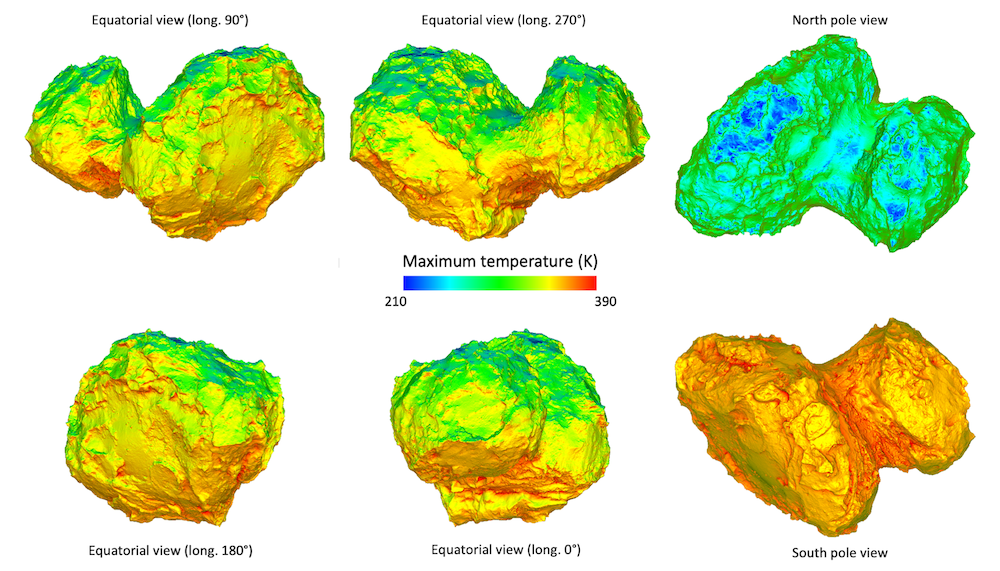The thermal environment of comet 67P/Churyumov-Gerasimenko
- 1Aix Marseille Univ, CNRS, CNES, LAM, Marseille, France (olivier.groussin@lam.fr)
- 2Instituto de Astrofísica de Andalucía - CSIC, Glorieta de la Astronomía s/n, 18008 Granada, Spain
- 3Institut für Geophysik und extraterrestrische Physik, Technische Universität Braunschweig, Mendelssohnstr. 3, 38106 Braunschweig, Germany
Comets are among the most primordial objects of the solar system. According to Davidsson et al. (2016), they did not suffer from collisional processing, and remained mostly thermally unaltered since their formation, including by radiogenic heating. When a comet is injected into the solar system, either from the Oort cloud or from the Kuiper belt (e.g., Dones et al. 2004, Duncan et al. 2004), the above remains true for the nucleus deep interior but not for its upper surface, i.e. the first meters, which experiences a strong increase in insolation. This increasing insolation is the main driver for cometary activity and nucleus erosion (e.g., Whipple 1950).
In this work, we focus on the effects of insolation on comet 67P/Churyumov-Gerasimenko (hereafter 67P), the target of the Rosetta mission, over a complete revolution around the Sun. We aim to better understand the thermal environment of the nucleus of 67P: the temperature variations on the nucleus surface, erosion, connections with global and local topography, and how insolation affects the nucleus interior temperature for the presence of volatile species such as H2O and CO2.
For this work, we developed two thermal models, combined with the nucleus shape model of comet 67P (Preusker et al. 2017), to compute the nucleus surface and interior (the first meters) temperature over a complete revolution of 67P, i.e. 6.45 yr. Our first thermal model has a high spatial resolution of 300 000 facets and compute only the surface temperature, while our second thermal model has a lower spatial resolution of 10 000 facets but includes heat conductivity to compute the temperature inside the nucleus down to about 3 meters.
Figure 1 is a result of our first thermal model, and shows the maximum temperature reached over the orbit. Globally, the maximum temperature is the highest in the Southern hemisphere (SH) with 350 – 400 K, followed by the equatorial regions with 300 – 350 K, and then by the Northern hemisphere (NH) that is the coldest with 210 – 300 K. This directly reflects seasonal effects. Remarkably, cliffs in the NH (e.g., Seth region) are significantly hotter than the surrounding plains, by 50 – 100 K; their orientations allow a longer insolation when approaching the Sun and delay the beginning of the polar night close to perihelion. At the equator (e.g., Imhotep region), the cliffs facing South are hotter than the plains by 50 K, while the cliffs facing North are colder than the plains by 50 K. Overall, cliffs and plains behave differently due to their different orientation relative to the Sun. Finally, the maximum temperature is always higher than the sublimation temperature of water ice (180 K), therefore there exists no region on 67P where water ice is stable all around the orbit.
Figure 2 is a result of our second thermal model, and shows the maximum temperature reached over one revolution, at various depths: at the surface, at 5 cm depth (below the diurnal thermal skin depth) and at 1 m depth (below the seasonal thermal skin depth). At 5 cm depth, the temperature already drops significantly, down to 250 – 300 K in the SH and down to 150 – 200 K in the NH. The sublimation of water ice is still possible everywhere, excepted on the cliffs located on each side of the neck in the NH, and in large deep holes in the NH. At 1 m depth, temperature is even lower, from 70 – 100 K in the SH to 100 – 170 K in the NH. The sublimation of water is only possible in the Northern terrains located in the Ma'at and Ash region, facing North. Finally, the sublimation of CO2 ice is possible everywhere on the nucleus down to 1 m depth, since the temperature is always larger than 70 K. To summarize, inside the nucleus, the temperature is lower in the SH than in the NH, since the SH receives a short and strong pick of insolation at perihelion, which only heat superficially the nucleus compared to NH that is heated for a much longer time, so that the energy can penetrate deeper inside the nucleus.
The above results are just two examples of many scientific questions that can be address with our thermal models, and more examples will be shown at the conference.
References
Davidsson et al., 2016, A&A, 592, A63 432
Dones et al., 2004, in Comets II, 433 ed. M. C. Festou, H. U. Keller, & H. A. Weaver, 153
Duncanet al., 2004, in Comet II , 433 ed. M. C. Festou, H. U. Keller, & H. A. Weaver, 193
Keller et al., 2015, A&A, 583, A34
Preusker et al., 2017, A&A, 607, L1
Whipple, 1950, ApJ, 111, 375

Figure 1 – Maximum temperature (K) reached at the surface of 67P over one revolution. The results were obtained with our thermal model that has 300 000 facets.

Figure 2 – Temperature at various depths. The results were obtained with our thermal model that has 10 000 facets.
How to cite: Groussin, O., Jorda, L., and Attree, N.: The thermal environment of comet 67P/Churyumov-Gerasimenko, Europlanet Science Congress 2024, Berlin, Germany, 8–13 Sep 2024, EPSC2024-190, https://doi.org/10.5194/epsc2024-190, 2024.